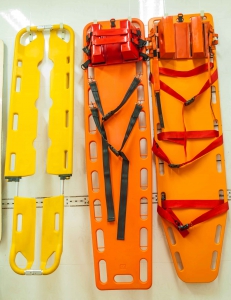Across the country we are moving further away from spinal immobilization with a spine board.
The rationale for this is the likelihood of a spinal cord injury is very low. A National Spinal Cord Injury Statistical Center’s report revealed the U.S. has 54 cases of spinal cord injury per 1 million people annually. The New England Journal of Medicine article, “The Canadian C-Spine Rule Versus the Nexus Low-Risk Criteria in Patients with Trauma,” states there are about 13 million people per year who are at risk of a spinal cord injury. That means that fewer than 1% of trauma patients will suffer a spinal cord injury. Because of this information, long spine board immobilization is slowly being phased out nationwide for patients involved in a traumatic event who meet specific criteria established by the National Emergency X-Radiography Utilization Study (NEXUS).
This applies as long as the patient is classified as falling into the Nexus Low-Risk Criteria, which consists of the following five items:
- The patient does not have mid-line cervical spine tenderness in the posterior region.
- There is no evidence of intoxication. Keep in mind, alcohol is a diagnosis of exclusion, meaning alcohol should be the last rule out you should consider.
- The patient is alert and oriented x 4 — person, place, time and event.
- The patient does not have a focal neurologic deficit.
- There are no distracting injuries.
We know the alert patient does a better job of protecting themselves from further injury because of the inflammatory response. This would be the one-time histamines are a good thing.
Do you turn your head to look at someone when you have a “kink” in your neck? No, you know your limitations and you turn your entire body to minimize the pain.
Other uses for the long spine board
More effective CPR
I was teaching a class a few months ago and a student said his agency had completely removed long spine boards from service. I was floored.
What’s the issue? First, as we can see above, NEXUS lays out very specific criteria in which spinal immobilization is needed. But we have other uses for long spine boards.
We cannot do CPR directly on a gurney mattress. We know doing chest compression on a mattress decreases the effectiveness. And, considering we achieve 30% of the patient’s normal cardiac output at best, that’s huge. Yet, how many of you have witnessed or allowed chest compression to be performed directly on the gurney? I have seen it more times than I can count.
Stopping tube displacement
What about the causes of a lost endotracheal tube? Our new mnemonic is DOPER — displacement of the tube, obstruction, pneumothorax, extubation and the newest edition is rigidity — because of the increasing pre-hospital use of fentanyl.
The most common issue is tube displacement, which is especially true among the pediatric population.
A neck movement study sponsored by the Beijing Tsinghua Chang Gung Hospital found that flexing the patient’s head resulted in moving the endotracheal tube toward the patient’s carina and extending the head resulted in the opposite.
These movements resulted in either endobronchial intubation or accidental extubation. Both issues are life-threatening if they go uncorrected.
If there is a return of spontaneous circulation the patient is moved a minimum of two times, floor to gurney and gurney to hospital bed.
If we take 90 seconds and place the patient in spinal immobilization and remember to apply padding correctly, we decrease the risk of an endotracheal tube displacement.
I can’t even guess at the number of times I have been on a cardiac arrest patient and was questioned as to why I was placing a non-trauma patient into spinal immobilization. My response: “We are going to do this, and we can talk about it after the call is over.”
It’s better for you, too
We also need long spine boards to assist with lifting and to protect our backs. Have you ever lifted dead weight? It’s awkward and can throw us off balance very easily.
Back injury risk grows
We also have an obesity problem in the U.S. In 2016, the Centers for Disease Control and Prevention reported that 93.3 million people classified as obese. That’s 39.8% of the population.
We spend $20 billion on healthcare-related back injuries, according to the Occupational Safety and Health Administration (OSHA). These costs include visits to the emergency department, workman’s comp, physical therapy, lost wages, paying overtime for someone to backfill your shift, and potentially back surgery and retraining.
According to OSHA, in 2012 nursing and residential care workers were two times more likely to suffer a back injury than a construction worker. I think it is safe to say that those of us working in EMS have an equal, if not higher risk of injury, than those working in a facility.
OSHA recommends six elements to minimizing back injuries:
- Input from employees who work with patients
- A management team that commits to a safe-lifting program
- Hazard assessment
- Technology
- Training
- Equipment
The long spine board is the equipment you can and should be using to move the patient. And not just obese patients, but all patients.
We know lifting an obese patient can result in an injury, but we can be injured moving smaller patients too. When you take the time to immobilize the patient properly you ensure there is not an unexpected shift in the patient’s weight. You also make lifting a more formal process because you have to squat down and keep your back straight.
To the agencies that have removed long spine boards from service, please put them back on the units. Your budgets and, more importantly, your crew’s backs, will thank you.

